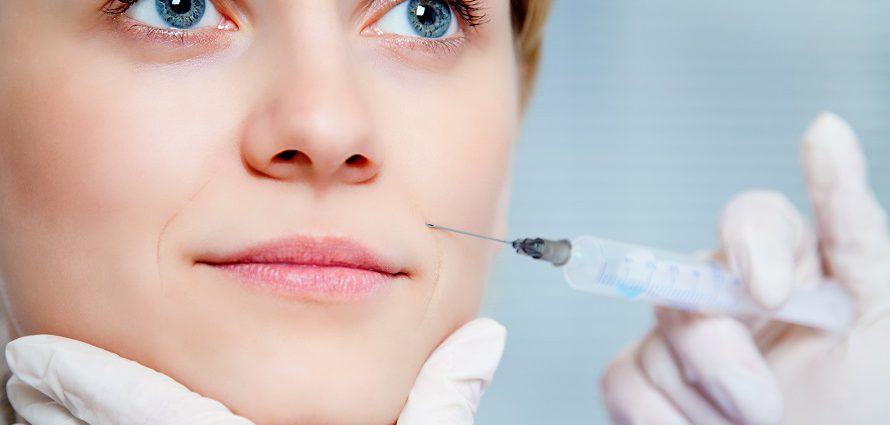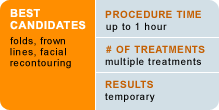Fat Fillers – Benefits, Cost & Side Effects

Reviewed by Michael Olding, MD, FACS

If you want to plump up sunken cheekbones, fill in stubborn facial lines, create more supple lips or enhance your breasts, you may want to consider fat injections.
Fat injections are a popular short-term solution to temporarily improve the appearance of hollow cheeks, thin lips, an aging forehead, eyes, and scars. They can also be used on a limited basis to enhance breasts in a process called breast augmentation fat transfer. There is no need for concern about a foreign substance in your body since the fat used in the injection is taken directly from another area of your body.
Ideal Candidates
People who use fat injections may be any age. The best candidates for fat injections are well educated about the procedure and fully able to comply with aftercare instructions. Repeated treatments may be necessary — good candidates are prepared for multiple sessions in order to achieve their desired results. In order to be a candidate for fat injections, patients must have excess fat in another part of the body from which to harvest the fat injection.
The Procedure
The procedure is performed in the doctor’s office under local anesthesia. Patients may experience minimal discomfort from the needle injection. Depending on the extent of treatment, the procedure can take from 30 to 90 minutes. Patients return home shortly after the procedure is finished.
First, an antiseptic is applied to two areas: the location of the fat to be removed from your body, and the target areas that will receive the fat injection.
Fat cells are then removed from the buttocks, stomach, or thighs with a syringe or cannula (a thin hollow tube) that is connected to a vacuum device.
After the fat cells are suctioned, they are processed and purified by the doctor. During the so-called stem cell face lift, stem cells in the fat cells are processed using a special device or “activated” via drugs, chemicals or lasers. The fat is then injected beneath the skin into the target area. A bandage may be applied at this time.
Results are fully evident within one week. Fat fillers never result in 100 percent improvement of wrinkles, scars, hollow cheeks, or thinned lips; nor are the results permanent. Results can last as little as a few weeks or as long as one year.
Transplanted fat cells will die without blood supply within three to four days at body temperature. It takes three to four days until the first capillaries are reaching the injected fat cells. Therefore, the “take” of fat cells is always a gamble; some survive forever, while most of them don’t take and are reabsorbed in the body.
Recovery
After the procedure, patients may experience rather strong swelling and some bruising. The swelling may last for several weeks or months. The treated area may appear reddish in color within the first 48 hours. Scabs may form as well. Most often, normal activities can be resumed immediately. Patients are advised to stay out of the sun. Unmanageable pain or symptoms that are progressive or abnormal should be reported to the doctor immediately.
Complications and Risk
Complications are possible with any medical procedure; however, complications from fat injections are typically minimal. Complications may include uneven texture of the skin, infection, abscess, and scarring. In some cases, the area may be overfilled or underfilled.
Alternative and Additional Treatments
There may be alternative treatment options, depending on your condition. Other minimally invasive procedures include Botox, Restylane, Laviv and vampire injections. For severe signs of aging, surgical procedures such as eyelid surgery, facelift and forehead lift may be more appropriate.
Your doctor may recommend additional skin-surface treatments, which might include chemical peel, laser skin resurfacing or microdermabrasion.
Consult a Qualified Doctor
Plastic surgeons and dermatologists may have extensive experience with many anti-aging procedures including fat injections. Finding a doctor with specific experience in the procedure is important for achieving optimal results. Consulting a qualified doctor will help ensure that you receive the most appropriate treatment for your condition.
Here are some tips to consider when consulting a doctor:
- Review the doctor’s credentials, education, training, type of certification held, and number of times that the treatment has been performed in the practice.
- View before-and-after photos of patients with similar conditions who received fat injections and alternative procedures.
- Ask about complication risks and possible side effects.
- Ask your doctor to estimate the number of treatments required to achieve and maintain the results.
- Ask for a list of pre-op and post-op instructions. Following these instructions can reduce the risk of complications.
Cost
The extent of the procedure may involve one or several areas of the body. The appropriate dosage for each area and the thickness of the filler required for each area can differ, making it difficult to provide a meaningful cost estimate until you are examined by a doctor.
The cost for fat injections can range from a minimum of $350 to more than $5,000 if the entire face is treated.
Since the treatment is unpredictable, you will need to consider the possible lifetime expense in order to evaluate the true impact on your budget.
Some of the cost can be covered by insurance if the procedure is related to a medical necessity, such as treatment of scars that occur from injuries. You can ask your surgeon about filing for insurance. Purely cosmetic procedures are not covered by insurance.
About the Reviewer of This Article
Michael Olding, MD, FACS, of Washington, D.C. is board-certified in plastic and reconstructive surgery by the American Board of Plastic Surgery and is a member of the American Society of Plastic Surgeons, the Northeastern Society of Plastic Surgery and the National Capital Society of Plastic Surgeons, where he was elected president. Dr. Olding specializes in cosmetic plastic surgery procedures and clinically related activities in cosmetic surgery, cosmetic facial surgery, breast augmentation and reduction, rhinoplasty, body contouring, liposuction and melanoma. He is also one of the area experts on soft-tissue fillers (Restylane, Sculptra and Botox). He received his doctorate in medicine from the University of Kentucky in 1980 and completed his internship at Cornell Medical Center. He completed his fellowship in plastic and reconstructive surgery at McGill University in Montreal. Dr. Olding maintains hospital staff privileges at George Washington University Medical Center, Sibley Hospital and Children’s Hospital in Washington, D.C. More about Dr. Michael Olding


